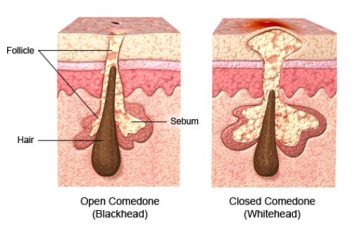Hi readers! Hope your week is going well. 🙂
Nothing crinkles the nose faster than the sight of blackheads taking up residence on your face. It’s expected during our teenage years when our body is going through changes but sometimes you find that they continue to form on your face well past your puberty stage. So, what are blackheads and more importantly, what can you do to manage them? Let’s take a look.
Blackheads/Whiteheads Defined
Blackheads and whiteheads fall into a category known as comedones. A comedone is caused when the follicle (pore) becomes congested with dead skin cells, sebum (oil), and other debris.
Open comedones, or blackheads, are open at the surface and exposed to air. This causes the sebum and debris to oxidize resulting in their dark color. Closed comedones, or whiteheads, form when the pore is completely blocked and no air enters the plugged follicle.
Causes of Blackheads/Whiteheads
- Excessive oil production
- Build up of dead skin cells
- Improper cleansing
- Using products that are not compatible to your skin type
How to Treat Blackheads/Whiteheads
Thorough Cleansing
Make sure that when you’re cleansing your face, you also focus on the hairline where blackheads and whiteheads can form. Also, make sure that your not aggressively stripping your skin with a harsh cleanser as this can cause your skin to produce more oil to compensate for moisture loss.
Regular Exfoliation
Make sure to exfoliate your skin regularly, about 2-3 times per week, to help remove the accumulation of dead skin cells. *Note: Don’t overly scrub skin as this will result in further irritation and you can really damage skin. Also, if you have inflamed acne, avoid using scrubs and opt for a BHA or enzymes to help with congestion.
Reducing Oil Production
Using a clay based mask about 2-3 times per week, can help draw out impurities and absorb excess oil. Ingredients such as niacinamide, zinc gluconate, and salicylic acid can help regulate oil production.
Keeping Tabs on Makeup and Skincare Items
Sometimes certain types of makeup can contribute to the formation of blackheads and whiteheads. Isopropyl Myristate can be a comedogenic ingredient for some. Using the right skincare products for your skin type also helps. Whereas mature skin would require a thicker moisturizer, skin that is oily should choose something more light-weight such as a gel or lotion.
Seek a Professional
Scheduling an appointment with a dermatologist or esthetician is another option if you’re looking for a deep cleaning of your pores. They can utilize different techniques and tools to help facilitate the removal of blackheads as well as guide you to products that would work best for you.
Was this information helpful to you? Let me know in the comments below!
Stephanie

Thankyou so much for this information!:)
You’re welcome! I’m glad you found this helpful. 🙂
Super helpful! What are your thoughts on sebaceous filaments? I only learned about them a couple of years ago – I thought I had blackheads but they weren’t blackheads.
Yay! As for the sebaceous filaments, hang on to this question Stash. I need to do some research and go back to my books as I can’t quite recall this at the moment. I will get back to you soon!